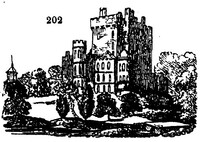619. The first attempts to introduce the modern style into Ireland are supposed to have been made by Dr. Delany at Delville, near Glasnevin, about the year 1720. Swift has left a poetical description of these scenes. Dr. Delany, Walker says, 'impressed a vast deal of beauty on a very small spot of ground; softened the obdurate straight line of the Dutch into a curve, melted the terrace into a sloping bank, and opened the walk to catch the vicinal country.' Walsh (History of Dublin, 1820) says, these grounds retain all the stiffness of the old garden. As there existed an intimacy between Pope and Delany, it is supposed the former may have assisted his Irish friend. This example appears to have had the same sort of influence in Ireland that the gardening of Lord Kames had in Scotland; it gave rise to a demand for artists of the new school, and the market was supplied by such as came in the way. Much less, however, was done in that country, partly from the abundance of picturesque scenery in many districts, and partly from other obvious causes. Mount Shannon, near Limerick, the seat of the late Chancellor Clare, is said to have been laid out from his lordship's designs; and the recent improvements at Charleville Forest, where one of the most comfortable and magnificent castles in Ireland has been executed by Johnson of Dublin, were the joint productions of Lord and Lady Charleville. Walker mentions Marino, Castletown, Carton, Curraghmore, the retreat of St. Woolstans, and Moira, as exhibiting the finest garden-scenery in Ireland. Powerscourt, and Mucruss, near the lakes, are reckoned the most romantic residences, and are little indebted to art. The illiberality of the owner of Powerscourt, in shutting it up on Sundays, has been finely ridiculed by Prince Puckler Muskau (Tour, &c. vol. i. p. 198.), who, passing it on a Sunday, 'pursued his way along a high wall, over which, from time to time, he cast a longing and stolen glance at the magnificent waterfalls and enchanting scenery.' St. Valori, Walker's own seat, is a beautiful little spot, near the well-known village of Bray. Miss Plumtre mentions Blarney Castle (fig. 202.), as one of the most enchanting spots in the world. There have been delightful shrubberies, which might easily be restored. The castle stands on a rock not very high, and below are fine meadows, with an ample stream flowing through them; there is plenty of wood, and a considerable lake at a short distance from the house, which furnishes excellent trout: in short, nature has left little for art to supply; and yet this charming spot is deserted, abandoned, looking wholly neglected and forlorn. (Residence in Ireland, 1817, p. 240.) The seats of Mr. Bourne, and of Counsellor West, near Dublin, are much indebted both to art and nature, and are among the most beautiful villa residences in Ireland.

